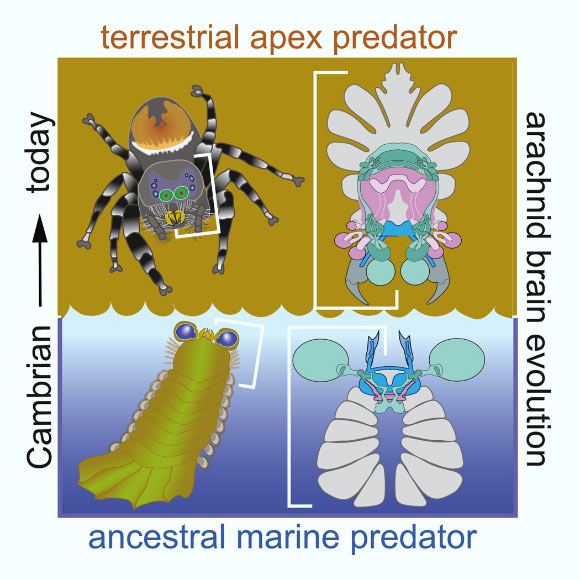
Arachnids Originated in Cambrian Seas, New Research Suggests
How did your country report this? Share your view in the comments.
Diverging Reports Breakdown
Arachnids Originated in Cambrian Seas, New Research Suggests
Paleontologists have analyzed the fossilized features of the brain and central nervous system of Mollisonia symmetrica, an extinct animal that lived in the mid-Cambrian seas around 508 million years ago. Their results show that the animal’s nervous system corresponds to that of living spiders and scorpions. This discovery challenges the widely held belief that the diversification of arachnids happened only after their common ancestor had conquered the land. The fossilized brain also revealed an unsegmented brain extending short nerves to a pair of pincer-like claws, reminiscent of the fangs of spiders and other archnids. The first creatures to come onto land were probably millipede-like arthropods and probably ancestral insect-like creatures, like crustaceans, insects and centipedes, say the researchers. The discovery could help scientists better understand the evolutionary history of spiders, scorpions and millipedes and the evolution of land life on the planet.
Until now, Mollisonia symmetrica was thought to represent an ancestral member of a specific group of arthropods known as chelicerates, which lived during the Cambrian period and included ancestors of today’s horseshoe crabs.
To their surprise, University of Arizona’s Professor Nicholas Strausfeld and his colleagues found that the neural arrangements in the animal’s fossilized brain are not organized like those in horseshoe crabs, as could be expected, but instead are organized the same way as they are in modern spiders and their relatives.
“It is still vigorously debated where and when arachnids first appeared, and what kind of chelicerates were their ancestors, and whether these were marine or semi-aquatic like horseshoe crabs.”
Mollisonia symmetrica outwardly resembles some other early chelicerates from the lower and mid-Cambrian in that its body was composed of two parts: a broad rounded carapace in the front and a sturdy segmented trunk ending in a broad, tail-like structure.
Some scientists have referred to the organization of a carapace in front, followed by a segmented trunk as similar to the body plan of a scorpion.
But nobody had claimed that Mollisonia symmetrica was anything more exotic than a basal chelicerate, even more primitive than the ancestor of the horseshoe crab, for example.
What Professor Strausfeld and co-authors found indicating Mollisonia symmetrica’s status as an arachnid is its fossilized brain and nervous system.
As in spiders and other present-day arachnids, the anterior part of Mollisonia symmetrica’s body (called the prosoma) contains a radiating pattern of segmental ganglia that control the movements of five pairs of segmental appendages.
In addition to those arachnid-like features, Mollisonia symmetrica also revealed an unsegmented brain extending short nerves to a pair of pincer-like claws, reminiscent of the fangs of spiders and other arachnids.
But the decisive feature demonstrating arachnid identity is the unique organization of the mollisoniid brain, which is the reverse of the front-to-back arrangement found in present-day crustaceans, insects and centipedes, and even horseshoe crabs, such as the genus Limulus.
“It’s as if the Limulus-type brain seen in Cambrian fossils, or the brains of ancestral and present-day crustaceans and insects, have been flipped backwards, which is what we see in modern spiders,” Professor Strausfeld said.
“The latter finding may be a crucial evolutionary development, because studies of existing spider brains suggest that this back-to-front arrangement provides shortcuts from neuronal control centers to underlying circuits that coordinate a spider’s (or its relative’s) amazing repertoire of movements,” said Dr. Frank Hirth, a paleontologist at King’s College London.
“This arrangement likely confers stealth in hunting, rapidity in pursuit and in the case of spiders, an exquisite dexterity for the spinning of webs to entrap prey.”
“This is a major step in evolution, which appears to be exclusive to arachnids.”
“Yet already in Mollisonia symmetrica, we identified brain domains that correspond to living species with which we can predict the underlying genetic makeup that is common to all arthropods.”
“The arachnid brain is unlike any other brain on this planet, and it suggests that its organization has something to do with computational speed and the control of motor actions,” Professor Strausfeld said.
“The first creatures to come onto land were probably millipede-like arthropods and probably some ancestral, insect-like creatures, an evolutionary branch of crustaceans.”
“We might imagine that a Mollisonia symmetrica-like arachnid also became adapted to terrestrial life making early insects and millipedes their daily diet.”
“The first arachnids on land may have contributed to the evolution of a critical defense mechanism: insect wings, hence flight and escape.”
“Being able to fly gives you a serious advantage when you’re being pursued by a spider.”
“Yet, despite their aerial mobility, insects are still caught in their millions in exquisite silken webs spun by spiders.”
The results appear in the journal Current Biology.
_____
Nicholas J. Strausfeld et al. Cambrian origin of the arachnid brain. Current Biology, published online July 22, 2025; doi: 10.1016/j.cub.2025.06.063
Source: https://www.sci.news/paleontology/mollisonia-symmetrica-14088.html
